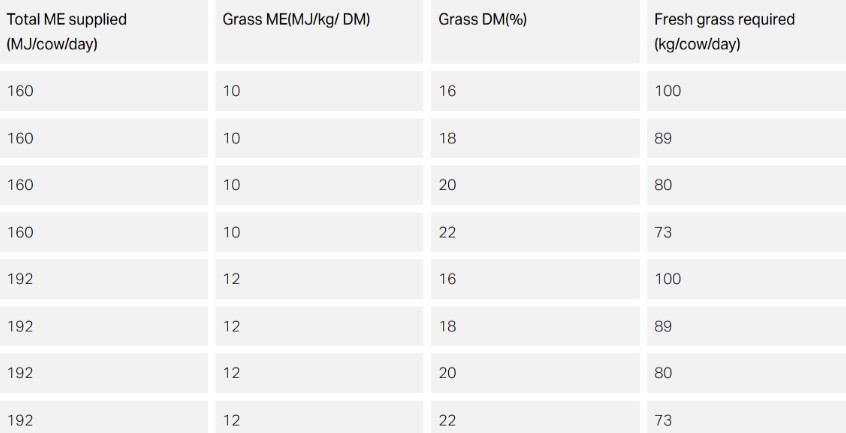Fresh green grass is a welcome sight in spring, but early-season pasture with limited growth or volume requires careful management when used as the main source of nutrition for recently calved cows
With insufficient grass volume, cows may not meet their energy and protein needs, leading to a loss in body condition. While fresh grass is an excellent source of nutrition, its dry matter content fluctuates significantly due to weather conditions, growth stage, and management practices. This variability can lead to cows consuming less energy than expected, impacting performance and body condition. To prevent production dips and metabolic stress, farmers must carefully manage the transition to grazing and ensure cows have access to energy-dense and palatable feeds.
Managing the Transition to Grazing
It’s easy to assume that cows get everything they need from lush spring grass. However, the reality is that grass dry matter levels change rapidly, and excessive water content can dilute the available nutrients. If cows don’t consume enough dry matter, their energy intake drops, leading to reduced milk yields, weight loss, and fertility challenges.
Another common mistake is overestimating how well cows adapt to dietary changes. A sudden shift from winter rations to a full-grazing system can disrupt rumen function,and negatively affect feed efficiency. Instead of allowing cows to adjust gradually, an abrupt change can cause digestive upset, lower intake, and impact overall performance.
A Structured Approach to Grazing Nutrition
To ensure cows continue to meet their energy needs, farmers should follow a step-by-step transition plan that includes:
Setting Up 2-3 Diets – Instead of moving cows straight onto full-time grazing, gradually introduce grass alongside existing feeds. A phased approach helps maintain rumen stability and prevents digestive upsets.
Monitoring Grass Dry Matter – Regularly assessing grass dry matter levels ensures accurate feeding adjustments. When dry matter content is low, additional supplementation is required to maintain performance.
Using Energy-Dense Feeds – Supplementing with highly palatable, high-energy feeds helps bridge nutritional gaps and stabilise production. Specialist Nutrition offers targeted solutions to complement grazing diets.
Key Products to Support Grass-Based Diets
Enerbot Pro – A liquid energy and protein feed designed for robotic milking systems, ensuring cows receive the right nutrients on an individual basis. This helps maintain energy intake even as diet composition shifts.
Sugar – A fast-acting, highly digestible energy source that stimulates appetite and supports rumen function. When included in the diet, sugar encourages cows to maintain dry matter intake, particularly in periods of dietary transition.
Grass Watch & Feeding Guidelines – Specialist Nutrition provides expert guidance on grass dry matter fluctuations and tailored feeding strategies to ensure cows receive a balanced diet throughout the grazing season.
Understanding Dry Matter in Grass: Why It’s Essential for Grazing and Forage Management
Dry matter (DM) refers to the percentage of a plant’s total content that remains after the removal of water. This includes the plant’s fibres, proteins, ash, water-soluble carbohydrates, and lipids. By understanding the DM content in grass and forage, farmers can manage their livestock’s nutritional intake more effectively.
The dry matter percentage is crucial because it directly influences the amount of fresh forage needed to meet a specific nutrient requirement. A lower DM content means that more fresh weight of grass or conserved forage will be necessary to achieve the target intake. This is especially relevant for both grazed grass and preserved forage.
The Variability of Dry Matter in Grass
The DM content of grass can vary significantly due to factors like field conditions and weather patterns. Additionally, the type of grass—diploid versus tetraploid—affects the DM content. Diploid grasses typically have a higher DM content (about 2% more than tetraploids) because of their smaller cell structure and lower cell wall-to-cell contents ratio.
This means that livestock grazing on a tetraploid sward may need to consume more fresh grass to meet the same nutritional needs as those grazing on a diploid sward.
In terms of yield, modern ryegrass varieties have been bred for maximum production, with top-rated perennial ryegrasses capable of yielding over 14 t DM/ha, while weed grasses, such as creeping bent or annual meadow grass, may produce as little as 2 t DM/ha. Ryegrass production follows a typical growth pattern, peaking at around 120 kg DM/ha per day in May and generally declining to about one-third of that peak by early autumn.

Maximising Dry Matter for Optimal Forage Quality
When grazing, the goal should be to manage the sward so that it offers a balance of fresh, nutritious growth with the right fibre content for efficient rumen passage. This is best achieved by implementing a grazing rotation of 18-21 days during the peak season. Poor sward management can lead to an increase in dead plant material, which significantly reduces both the quality and intake potential of the forage.
Key Dry Matter Tips:
- Use seasonal DM yield data when selecting the best varieties from the Irish Recommended List.
- Keep in mind that livestock on wet pasture will need to consume a greater amount of fresh forage to meet their nutritional requirements.
- Delaying silage cutting increases yield but can reduce forage quality.
Keep Energy Intake Consistent for Optimal Performance
By carefully managing the transition to grazing, monitoring grass dry matter, and providing the right nutritional support, farmers can ensure cows maintain peak performance without energy shortfalls. Specialist Nutrition’s expert team is on hand to help develop customised feeding plans that support milk production, fertility, and overall cow health. For more information on optimising grazing nutrition, contact Specialist Nutrition today.





